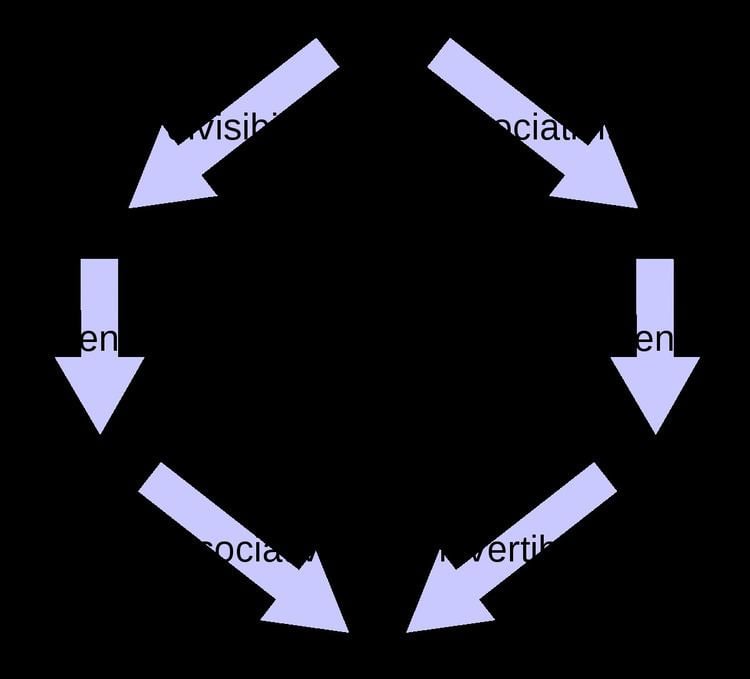Unneeded Required Unneeded Unneeded Unneeded Required | Required Unneeded Unneeded Unneeded Required Required | |
 | ||
In abstract algebra, a magma (or groupoid; not to be confused with groupoids in category theory) is a basic kind of algebraic structure. Specifically, a magma consists of a set, M, equipped with a single binary operation, M × M → M. The binary operation must be closed by definition but no other properties are imposed.
Contents
History and terminology
The term groupoid was introduced in 1926 by Heinrich Brandt describing his Brandt groupoid (translated from the German Gruppoid). The term was then appropriated by B. A. Hausmann and Øystein Ore (1937) in the sense (of a set with a binary operation) used in this article. In a couple of reviews of subsequent papers in Zentralblatt, Brandt strongly disagreed with this overloading of terminology. The Brandt groupoid is a groupoid in the sense used in category theory, but not in the sense used by Hausmann and Ore. Nevertheless, influential books in semigroup theory, including Clifford and Preston (1961) and Howie (1995) use groupoid in the sense of Hausmann and Ore. Hollings (2014) writes that the term groupoid is "perhaps most often used in modern mathematics" in the sense given to it in category theory.
According to Bergman and Hausknecht (1996): "There is no generally accepted word for a set with a not necessarily associative binary operation. The word groupoid is used by many universal algebraists, but workers in category theory and related areas object strongly to this usage because they use the same word to mean 'category in which all morphisms are invertible'. The term magma was used by Serre [Lie Algebras and Lie Groups, 1965]." It also appears in Bourbaki's Éléments de mathématique, Algèbre, chapitres 1 à 3, 1970.
Definition
A magma is a set M matched with an operation, •, that sends any two elements a, b ∈ M to another element, a • b. The symbol, •, is a general placeholder for a properly defined operation. To qualify as a magma, the set and operation (M, •) must satisfy the following requirement (known as the magma or closure axiom):
For all a, b in M, the result of the operation a • b is also in M.And in mathematical notation:
∀ a, b ∈ M: a • b ∈ M.If • is instead a partial operation, then S is called a partial magma or more often a partial groupoid.
Morphism of magmas
A morphism of magmas is a function, f : M → N, mapping magma M to magma N, that preserves the binary operation:
f (x •M y) = f(x) •N f(y)where •M and •N denote the binary operation on M and N respectively.
Notation and combinatorics
The magma operation may be applied repeatedly, and in the general, non-associative case, the order matters, which is notated with parentheses. Also, the operation, •, is often omitted and notated by juxtaposition:
(a • (b • c)) • d = (a(bc))dA shorthand is often used to reduce the number of parentheses, in which the innermost operations and pairs of parentheses are omitted, being replaced just with juxtaposition, xy • z = (x • y) • z. For example, the above is abbreviated to the following expression, still containing parentheses:
(a • bc)d.A way to avoid completely the use of parentheses is prefix notation, in which the same expression would be written ••a•bcd.
The set of all possible strings consisting of symbols denoting elements of the magma, and sets of balanced parentheses is called the Dyck language. The total number of different ways of writing n applications of the magma operator is given by the Catalan number, Cn. Thus, for example, C2 = 2, which is just the statement that (ab)c and a(bc) are the only two ways of pairing three elements of a magma with two operations. Less trivially, C3 = 5: ((ab)c)d, (a(bc))d, (ab)(cd), a((bc)d), and a(b(cd)).
The number of non-isomorphic magmas having 0, 1, 2, 3, 4, ... elements are 1, 1, 10, 3330, 178981952, ... (sequence A001329 in the OEIS). The corresponding numbers of simultaneously non-isomorphic and non-antiisomorphic magmas are 1, 1, 7, 1734, 89521056, ... (sequence A001424 in the OEIS).
Free magma
A free magma, MX, on a set, X, is the "most general possible" magma generated by X (i.e., there are no relations or axioms imposed on the generators; see free object). It can be described as the set of non-associative words on X with parentheses retained.
It can also be viewed, in terms familiar in computer science, as the magma of binary trees with leaves labelled by elements of X. The operation is that of joining trees at the root. It therefore has a foundational role in syntax.
A free magma has the universal property such that, if f : X → N is a function from X to any magma, N, then there is a unique extension of f to a morphism of magmas, f ′
f ′ : MX → N.Types of magma
Magmas are not often studied as such; instead there are several different kinds of magma, depending on what axioms the operation is required to satisfy. Commonly studied types of magma include:
Note that each of divisibility and invertibility imply the cancellation property.
Classification by properties
A magma (S, •), with x, y, u, z ∈ S, is called
Generalizations
See n-ary group.
